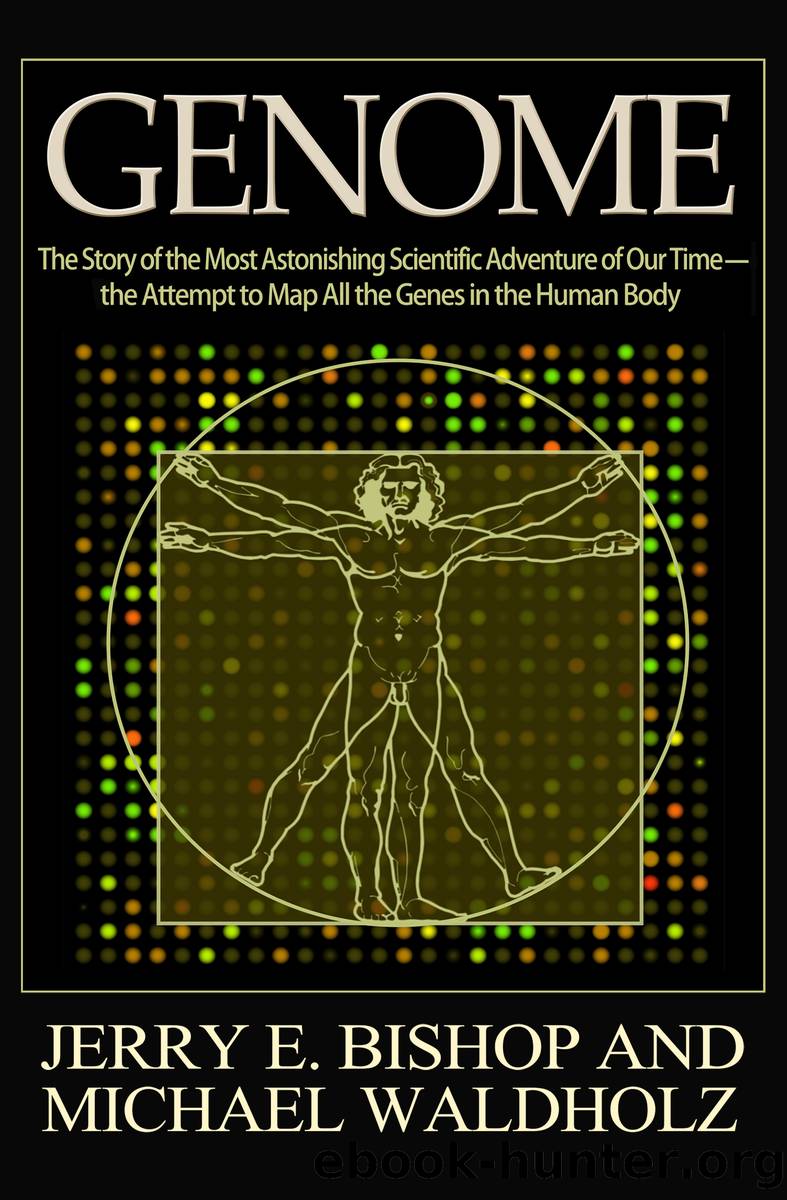Genome by Jerry E Bishop

Author:Jerry E Bishop
Language: eng
Format: epub
Publisher: Open Road Media
This last requirement means that cholesterol must be transported by the bloodstream to every nook and cranny of the body. Each cell, in turn, is constantly breaking down and rebuilding its membranes, taking in fresh cholesterol and disposing of âusedâ cholesterol. The used cholesterol has to be transported back to the liver for recycling and/or disposal.
This transport of cholesterol about the body is complicated by a simple chemical fact: Cholesterol does not dissolve in water. Technically, it is a fatty alcohol. In its pure state it looks and feels like a white wax. If dumped into the bloodstream in its pure state, it would simply float aimlessly about. To solve the problem of distributing this water-repellant cholesterol, nature over the eons evolved a complex system of protein carriers. These proteins do dissolve in water, that is, the molecules in the proteins literally latch onto water molecules. By wrapping a globule of cholesterol in a protein, the body manages to get the globule delivered to the cells by the watery part of the blood, the plasma.
The cholesterol transport system is a physiological labyrinth, made more so by the fact that the same system also transports the fats that come into the blood from the diet, fats also being insoluble in water. The distribution process essentially is a relay system with globules of cholesterol and fat being carried from one protein to another not unlike, to use an oversimplistic analogy, a basketball being passed from one player to another to move it down the court. It begins when one or more proteinsâthe exact details are still uncertainâgrab a globule of fat and cholesterol at the wall of the intestine and haul it out to the fat storage cells where much of the dietary fat is dumped off. The now-diminished globule is taken to the liver, where protein receptors on the liver cells grab the protein-wrapped fat-and-cholesterol package and pull it into the cell for processing.
When one set of cells completes its particular bit of processing, the package is dropped again into the bloodstream, rewrapped in new proteins, to be picked up by another set of cells for further processing. At each step, the package, known as a lipoprotein ("lipo-â being the prefix denoting fat), becomes more and more dense. Hence, at any one time a variety of fat-cholesterol packages are circulating in the bloodstreamâvery-low-density lipoproteins (VLDL), intermediate-density lipoproteins (IDL), low-density lipoproteins (LDL), and high-density lipoproteins (HDL).
It is the penultimate packageâthe LDL packageâthat is the much-publicized âbadâ cholesterol strongly linked to coronary heart disease. LDL is the form in which cholesterol is transported throughout the body to meet the cellsâ needs for making membranes. The final packageâHDLâis the form in which the âusedâ cholesterol leaves the tissues and returns to the liver for disposal. (Because HDL signifies the extraction and disposal of cholesterol, it is becoming known as the âgoodâ cholesterol, the more of it in the bloodstream the better for good health.)
The details of this cholesterol-transport system were just beginning to be
Download
This site does not store any files on its server. We only index and link to content provided by other sites. Please contact the content providers to delete copyright contents if any and email us, we'll remove relevant links or contents immediately.
Sapiens: A Brief History of Humankind by Yuval Noah Harari(14209)
Sapiens by Yuval Noah Harari(5280)
Pale Blue Dot by Carl Sagan(4883)
Homo Deus: A Brief History of Tomorrow by Yuval Noah Harari(4798)
Livewired by David Eagleman(3663)
Origin Story: A Big History of Everything by David Christian(3631)
Brief Answers to the Big Questions by Stephen Hawking(3354)
Inferior by Angela Saini(3260)
Origin Story by David Christian(3132)
Signature in the Cell: DNA and the Evidence for Intelligent Design by Stephen C. Meyer(3054)
The Gene: An Intimate History by Siddhartha Mukherjee(3029)
The Evolution of Beauty by Richard O. Prum(2924)
Aliens by Jim Al-Khalili(2775)
How The Mind Works by Steven Pinker(2713)
A Short History of Nearly Everything by Bryson Bill(2616)
Sex at Dawn: The Prehistoric Origins of Modern Sexuality by Ryan Christopher(2472)
From Bacteria to Bach and Back by Daniel C. Dennett(2432)
Endless Forms Most Beautiful by Sean B. Carroll(2413)
Who We Are and How We Got Here by David Reich(2385)
